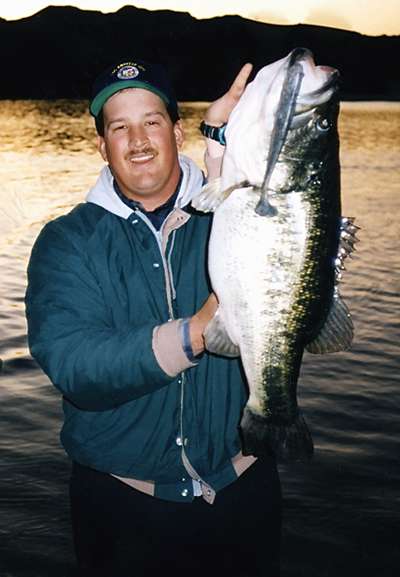
Every angler has a personal best, whether it's a 5-pound largemouth, a 3-pound spotted bass or a 4-pound smallmouth. They are each angler's crowning achievement. That number can change on any cast, and for legendary big bass hunter Bill Siemantel, that cast came in 1997 on the Castaic Lagoon, the site of his first double-digit bass.
Unlike his first big bass, which came trolling a wooden plug, Siemantel was casting for largemouth on this particular day. By this time he had graduated from the 14-foot Valco aluminum to a big bass boat rigged with state-of-the-art electronics. The lure he was throwing was an original Optimum soft plastic swimbait that he had turned into what was affectionately called a "limousine."
"We took two 8-inch baits and made them one 12-inch version by cutting and welding them together," he said. "After bonding the middle section of the bait, we would use a hot butter knife to smooth the joints so it would look natural.
The Castaic Lagoon is reserved for electric motors only. Anglers may trim their big motor out of the water, and use their trolling motor to navigate. It was while he was moving across the lake near closing time that Siemantel spotted two big marks on his sonar unit.
"I was passing a hump when I saw two big arches suspended at the windward side of the hump," he said. "The top of the hump sat in 12 feet with the bottom in 32, and the arches were suspended in 20."
He passed the marks, and turned his boat around on top of the hump, making a cast to deep water, allowing the heavy swimbait to sink toward the fish."
When his bait reached the bottom, Siemantel engaged his Shimano Calcutta 400 and began slow rolling the giant bait uphill toward the boat. When his bait began to turn up the side of the hump, he felt a strike. "I got a pretty good thump through my rod, so I set the hook hard," he said. "However, I missed the fish, and had to reel up the slack to feel the bait again."
About the time he came into contact with the bait, and could feel the weight of the lure on the tip of his Lamiglas Big Bait Special, he saw his line jump and turn a circle on the surface of the water. Using 25-pound-test Maxima Ultragreen line, Siemantel set the hook again, this time connecting with the fish.
"I made about 15 turns of the reel handle, and she was at the side of the boat," he said. "I scooped her into the net, and only then did I realize how big she was. I couldn't lift her with one arm; I had to use both."
He put the fish in the livewell and hurried back to the ramp where he and a game warden weighed the fish on a Berkley scale.
"The scale read 19.08, (19 pounds, 12.8 ounces) and my jaw dropped," said Siemantel. "I quickly took a picture with the fish, posing with the swimbait in her mouth, and then released her." The decision to release her was a shock to the game warden, who had witnessed the growth of Castaic's trophy hunter population that recorded everything officially in search of the world record.
To Siemantel, the thrill of the catch was enough, as were the lessons it taught him. "That fish taught me so much of what I use and share today," he said. "The common thought at the time was that fish always struck at the head, and that fish obviously struck the bait from behind, pushing it forward."
Along with the strike, Siemantel began to recognize the effect that fishing uphill could have on bass, as well as how much of a difference creating a directional change could make to a following bass. "Most anglers retrieve baits downhill, and I've gotten more strikes retrieving the bait in the opposite direction," he said. "I also get many strikes by either banging my bait against some cover or bottom feature, or creating a directional change myself by allowing the bait to pendulum, or by sweeping the rod, as I learned with that fish."
Siemantel has yet to best that fish, which would rank 12th on the Bassmaster Top 25 list if he had taken the time to certify it.
"I don't know if I will ever catch a bigger one," Siemantel says, "but I'll certainly keep trying."

